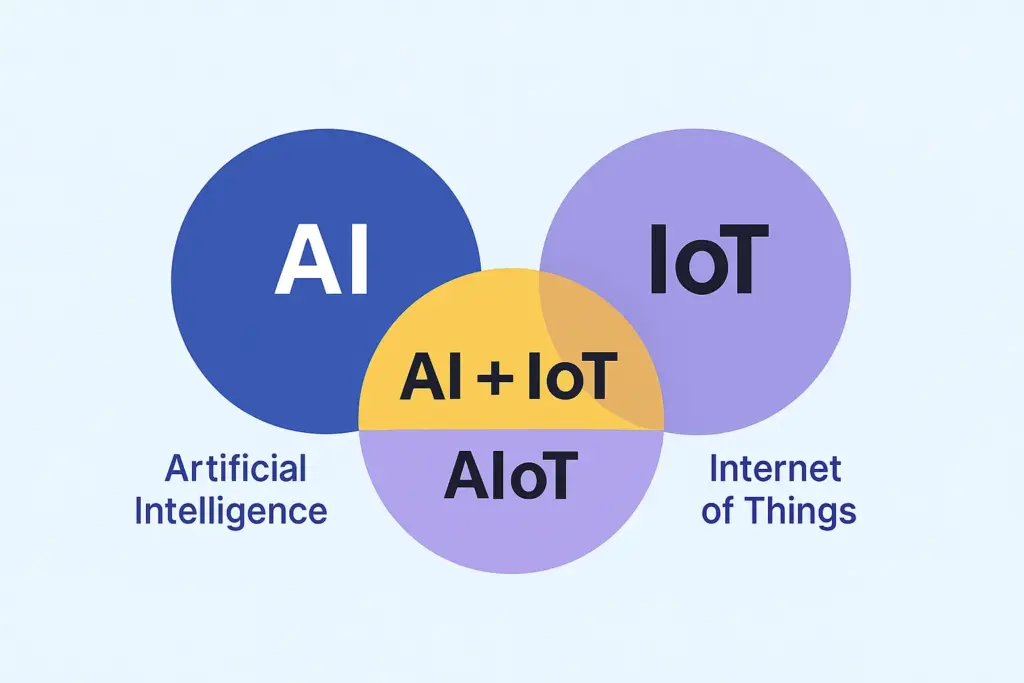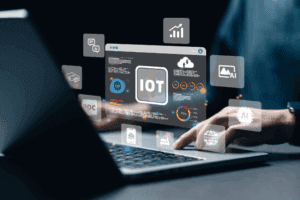Introduction – Difference Between AI and IoT
Understanding the difference between AI, IoT, and AIoT is essential for any team working on smart devices, automation, and intelligent systems.
AI provides thinking power, IoT provides sensory and communication power. When combined, they create intelligent connected systems.
This guide breaks down each concept in simple terms, provides clear comparison tables, and explains how businesses apply AIoT today.
What Is AI? (Artificial Intelligence Explained)
AI stands for Artificial Intelligence — the capability of machines to perform tasks that usually require human intelligence, such as learning, reasoning, and problem-solving.
Examples:
- Predictive analytics
- Voice assistants
- Image recognition systems
AI = the “brain” that processes data and makes decisions.
What Is IoT? (Internet of Things Explained)
IoT stands for Internet of Things — a network of devices connected via the internet, capable of collecting and sharing data.
Examples:
- Smart thermostats
- Wearable health trackers
- Connected industrial sensors
IoT = the “eyes, ears, and limbs” that sense and communicate.
AI vs IoT: Key Differences
Difference Between IoT and AI
The difference between IoT and AI lies in their roles in data handling and decision-making.
| Feature | AI | IoT |
|---|---|---|
| Function | Analyzes data, makes decisions | Collects & exchanges data |
| Intelligence | Data-driven reasoning | Basic sensing & communication |
| Applications | Prediction, automation | Monitoring, data gathering |
IoT and AI Difference in Simple Terms
- AI = Brain
- IoT = Eyes, ears, and hands
- AI + IoT = Smart connected systems
Understanding the IoT and AI difference helps in designing the right technology stack for your business.
What Is AIoT? (Artificial Intelligence of Things)
AIoT = AI embedded into IoT devices and systems, enabling smart, autonomous, and real-time decision making.
AIoT goes beyond “AI added to IoT.”
It creates a tightly integrated system where sensing, data processing, and decision-making work together across devices → edge → cloud.
AI vs IoT vs AIoT: Full Comparison Table
| Category | AI | IoT | AIoT |
|---|---|---|---|
| Definition | Intelligent algorithms | Connected devices | IoT enhanced with built-in AI |
| Main Role | Thinks & decides | Senses & communicates | Learns, analyzes & acts |
| Where Intelligence Lives | Cloud / algorithms | Devices / sensors | Edge + cloud + devices |
| Examples | Virtual assistants | Smart thermostats | Smart factories, autonomous systems |
| Value | Automation, prediction | Data collection | Real-time intelligence & autonomy |
How AI and IoT Combined → AIoT (The First Integration)

IoT first emerged, people imagined combining it with AI to enable better data insights and automated decision-making. This created the AI and IoT difference model in practice, often referred to as the AI+IoT model:
- AI models are added to existing IoT frameworks.
- Typically, cloud-based training and inference.
- Suitable for quick upgrades in existing systems.
This AI+IoT approach enabled smart upgrades but remained cloud-dependent, with latency and bandwidth limitations.
Why AIoT Is Different
AIoT represents the next stage:
AI runs not only in the cloud but also on the edge and sometimes directly on devices.
This means:
- Local real-time analysis
- Less reliance on cloud
- Better performance in time-critical scenarios
- Autonomous behavior in case of poor connectivity
How AIoT Works (Devices → Edge → Cloud)
An AIoT module for edge devices enables local decision-making and reduces reliance on cloud processing.
To visually illustrate the difference between “AI+IoT” and “AIoT,” below is a simple flowchart of the edge-cloud architecture, integrating IoT and embedded development key nodes.
flowchart LR A(End Device/Sensor) --> B[Edge Node] B --> C(Cloud Platform) C --> B B --> A C --> D{Industry Applications}
1. End Devices / Sensors (A)
Collect environmental or operational data (e.g., temperature, vibration, images).
2. Edge Node (B)
Preprocess data and run lightweight AI inference locally for real-time response.
3. Cloud Platform (C)
Provides large-scale training, storage, global coordination, and model updates.
4. Industry Applications (D)
Apply insights to real scenarios such as predictive maintenance, smart retail, energy optimization, and more.
Real-World AIoT Application Examples
1. Industrial IoT: Predictive Maintenance and Flexible Manufacturing
The industrial sector often experiences the first changes brought by AIoT, with the core value being improved production efficiency and reduced failure costs.
- AI+IoT Model: Sensors collect data like vibration and temperature, uploading it to the cloud, where machine learning models identify failure risks.
- AIoT Model: Edge nodes deploy embedded deep learning models for real-time analysis. If an anomaly is detected, other equipment in the workshop is immediately scheduled, reducing downtime.
2. Smart Cities: Traffic Scheduling and Energy Management
Traffic congestion and energy waste are major pain points in urban management.
- AI+IoT: City cameras upload traffic data to the cloud, where flow analysis and traffic light scheduling strategies are developed.
- AIoT: Cameras have initial object recognition, and edge nodes can adjust traffic lights based on local traffic. The cloud performs global optimization and sends strategies to edge nodes for efficient scheduling. In energy management, systems can locally adjust based on sensor data, while the cloud handles overall coordination based on weather predictions or historical energy consumption patterns.
3. Health Devices and Remote Medicine
With the rise of wearable devices, the demand for personal health monitoring and remote medical services has surged.
- AI+IoT: Devices like smartwatches or fitness bands collect metrics such as heart rate and blood oxygen, then upload this data to the cloud for analysis. Doctors can review the data and make diagnoses remotely.
- AIoT: Some high-end health devices can predict unusual heart rate fluctuations locally. If an anomaly is detected, the device can immediately send alerts to the hospital or family members.
4. Full-Home Integration in Smart Homes
The home environment is no longer just about remotely controlling lights, but is a large and intricate living system.
- AI+IoT: Each household device operates independently, sharing data in the cloud or receiving voice commands.
- AIoT: Lighting, temperature and humidity control, air quality monitoring, appliance management, and resident health monitoring are all interconnected. Real-time decisions are made through edge algorithms, while deep model training and home optimization are handled by the cloud.
AI + IoT vs AIoT – Deep Dive
When comparing IoT vs AIoT, the main distinction lies in how intelligence is embedded and deployed.
| Comparison | AI+IoT | AIoT |
|---|---|---|
| Origin | AI added to traditional IoT | AI built in from hardware to cloud |
| Architecture | Cloud-based inference | Edge + cloud + device collaboration |
| Cost & Implementation | Low-cost upgrades | Full stack, higher capability |
| Embedded Development | Basic sensing, cloud-heavy | Real-time edge optimization |
| Application Scenarios | Monitoring, basic smart features | Smart cities, Industry 4.0, energy systems |
| Future Trend | Still relevant for simple use cases | Becoming mainstream with more autonomy |
Why Embedded Development Matters in AIoT
To enable real-time processing and autonomous decision-making at the edge or device level in AIoT, embedded development is crucial for optimizing hardware platforms.
Effective AIoT requires optimized hardware and embedded algorithms, enabling:
- Local decision-making
- Lower latency
- Reduced network load
- Longer battery life for edge devices
- Real-time image recognition, diagnostics, and safety detection
This is essential in industries like smart cities, healthcare, and industrial automation.
Business Value Chain in AIoT
Hardware Manufacturers
- AI+IoT: Primarily provide basic sensors and networking modules with limited added value.
- AIoT: Integrate AI chips or algorithms at the device level to create high-value smart products and collaborate deeply with cloud service providers to build a complete service ecosystem.
Cloud Service and Platform Providers
- AI+IoT: Mainly offer big data storage, model training, and inference services.
- AIoT: Need to provide more comprehensive edge management, model distribution, and edge-side security to support businesses in seamlessly switching between localized and cloud-based operations.
Software and Algorithm Providers
- AI+IoT: Typically offer analysis functions in the form of cloud SDKs or APIs.
- AIoT: Must support both embedded development and cloud management, with more diverse algorithms that adapt to various hardware platforms and ensure cross-platform stability and performance.
Application Layer Innovation
- AI+IoT: Focuses on single-point applications such as facial recognition access control or remote monitoring.
- AIoT: Enables more complex integrated applications like a "smart community + remote healthcare + intelligent transportation" platform, combining healthcare data, traffic conditions, and community security to provide residents with comprehensive smart services.
Summary – How AI and IoT Converge in AIoT
- AI: Thinks and decides
- IoT: Connects and senses
- AI+IoT: Adds intelligence to existing IoT
- AIoT: Fully integrated smart ecosystem
AI+IoT and AIoT may differ by just one character in name, but in terms of architectural depth, business positioning, and future potential, they have significant differences. AI+IoT is more suitable for quickly layering AI models onto existing IoT systems to achieve intelligent upgrades, while AIoT represents a more comprehensive "bottom-up" fusion of AI, injecting stronger adaptive capabilities into the entire IoT ecosystem.
Regardless of the approach, both aim to breathe new life into traditional devices and environments: from industrial manufacturing to smart cities, from healthcare devices to everyday homes.
The combination of AI and IoT has a profound impact on productivity and lifestyles. In this wave, embedded development, edge-cloud collaboration, data security, and industry standardization will be key pillars in driving AIoT toward greater expansion.

FAQ
1. What is the main difference between AI and IoT?
AI analyzes and makes decisions; IoT senses and communicates data.
2. Is AI part of IoT?
No. AI and IoT are separate technologies but can work together.
3. What is AIoT used for?
Smart factories, predictive maintenance, smart retail, energy monitoring, connected healthcare, and more.
4. AI vs IoT vs AIoT—Which is better?
AI is good for decision-making, IoT for sensing; AIoT is best for real-time intelligent systems.
Recommended Reading
If you’re interested in learning more about AIoT and related technologies, check out these articles from our blog:
- What Is AIoT? Artificial Intelligence of Things Meaning & Examples – Discover AIoT meaning, definition, and how Artificial Intelligence of Things combines AI and IoT to power more intelligent devices and industries.
- AI-Driven IoT: How Big Models are Shaping the Future of AI-Driven IoT – How AI-Driven IoT Differs from Traditional AIoT.
- AIoT Leads the Next Horizon of IoT: Bridging Embedded AI Development with IoT Innovation – Learn how Embedded AI optimizes smart city systems with real-time data processing and decision-making solutions.
- DeepSeek + AIoT Evolution Guide – How DeepSeek Makes IoT Smart Devices Smarter and More Efficient.
Start Your AIoT Project with ZedIoT
From hardware integration to AI workflows, we help businesses build intelligent, scalable IoT systems.
→ Contact Us



